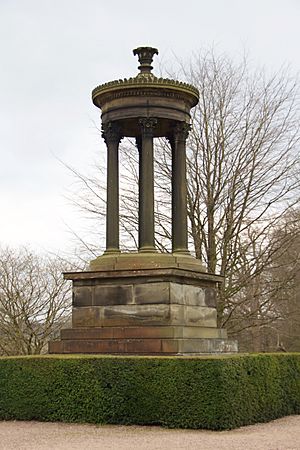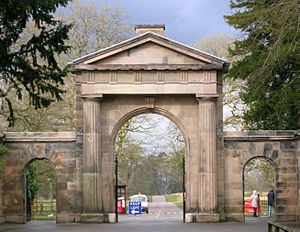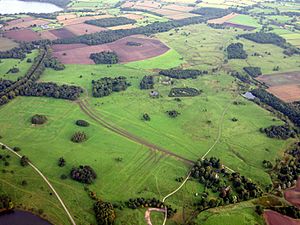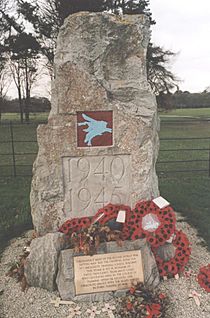Tatton Park facts for kids
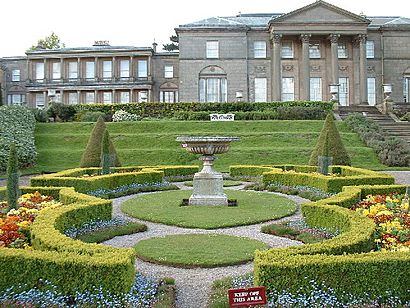
Tatton Park is a huge historic estate in Cheshire, England, located north of the town of Knutsford. It's a fun place to visit, with a big mansion called Tatton Hall, an older medieval house known as Tatton Old Hall, beautiful Tatton Park Gardens, a working farm, and a large deer park that's about 2,000 acres (8 km²) big. Many people visit Tatton Park, and it hosts over a hundred events every year, including the famous Royal Horticultural Society flower show. The National Trust owns the estate, and they manage it together with Cheshire East Council.
Contents
A Journey Through Time at Tatton Park
People have lived in the Tatton Park area since the Iron Age, a very long time ago! In medieval times, there was even a village called Tatton here, but it's gone now. You can still see where the village and its old roads were, and it's a protected historic site.
Who Owned Tatton Park?
By the late 1400s, the Stanley family owned the estate. They built and lived in the Tatton Old Hall. Later, in the 1580s, the Brereton family owned it and made the Old Hall even bigger. In 1598, a very important person named Sir Thomas Egerton, who was the Lord Chancellor of England, bought the estate.
Sir Thomas and his family didn't visit Tatton Park very often. They usually let other people live there. But by the end of the 1600s, Sir Thomas's grandson, John Egerton, owned the estate. He decided to build a brand new house, which is where the main mansion stands today, about 0.75 miles (1.2 km) west of the Old Hall. This new house, Tatton Hall, was made much bigger and grander between 1780 and 1813. At one point in 1795, the estate was huge, covering 251,000 acres (1,016 km²)! The Egerton family continued to own Tatton Park until the last Lord Egerton passed away in 1958.
Tatton Park Today
When the last Lord Egerton died, he left Tatton Hall to the National Trust. He also gave them the parkland instead of paying taxes. However, because the estate was sold by his family, the local council (Cheshire County Council, now Cheshire East Council) stepped in. They agreed to rent the park for 99 years to make sure it would be kept safe and open for everyone to enjoy. Today, the National Trust owns about 2,000 acres (8 km²) of the park.
The Hall and Park have become a popular place for visitors. There are always new things happening, and some new plans for the park have caused discussion.
Discovering the Old Hall
Tatton Old Hall is the original house on the estate. It was first built with wood, but later, bricks were used to make it stronger. The hall is shaped like an "L" and has two floors. Inside, some of the newer floors have been removed, so you can see the amazing old wooden roof structure.
The Old Hall is surrounded by a wall. Inside these grounds, you can find a rebuilt barn. This barn is made of wood with bricks in between, and it has a thatched roof, just like old barns used to. Most of the wood for this barn came from another old barn that was taken down. This barn is considered a special historic building.
Inside the Grand Tatton Hall
Tatton Hall is the main mansion at Tatton Park. A new house was built here around 1716 for the Egerton family. Over the years, especially between the 1770s and 1816, most of it was rebuilt into the beautiful neoclassical mansion you see today. Famous architects like Samuel Wyatt and his nephew Lewis William Wyatt designed it. More parts were added in 1861–62 and 1884. In the late 1800s, the hall was a busy place, hosting big parties with important guests, including kings and queens!
What You Can See Inside
The mansion is full of furniture made by a famous company called Gillows of Lancaster. There are over 150 pieces of furniture that were made just for the Egerton family! You'll also see a huge collection of paintings, including many portraits of the Egerton family. There are even paintings by famous artists like Canaletto, Poussin, and Van Dyck.
The Library holds special first editions of two books by the famous author Jane Austen. One room in the house is dedicated to a collection of interesting items from all over the world. These were collected by Maurice Egerton, the last owner of the house. You can also explore the servants' quarters, which show you how the staff lived and worked to keep the house running. Tatton Hall is part of the Historic Houses Association, which helps protect important historic homes.
Fun at the Farm
North of the mansion is Home Farm. This farm used to provide food and help with building work for the whole estate. Today, it looks much like it did in the 1930s, when electricity started to replace steam power for farm machines.
Now, Home Farm is open for visitors! You can see all sorts of farm animals there. The farm is special because it helps care for and breed rare types of farm animals. These include Tamworth pigs, Red Poll cows, and Leicester Longwool sheep. In 2007, the farm was recognized by the Rare Breeds Survival Trust for its important work.
Exploring the Beautiful Gardens
Tatton Park Gardens are located south of the main hall. They have both formal, neat sections and more wild, natural areas.
The Italian Garden
Right next to the hall is the Italian Garden. This is a very formal garden with two levels, and in the middle, you'll see a statue of Neptune, the Roman god of the sea. This garden was designed by Joseph Paxton and laid out by Edward Milner in 1847. It has been changed a bit over the years, but in 1986, it was brought back to its original design.
The Walled Garden
The main entrance to the gardens leads you into the Walled Garden. This garden has many different buildings, including glasshouses. It was restored in the 2000s and now grows the same kinds of fruits and vegetables that were grown at Tatton during the Edwardian era (early 1900s). East of the Kitchen Garden, you'll find the Conservatory, the Fernery, and the Showhouse.
Pleasure Gardens and Japanese Garden
Beyond the Walled Garden are the "Pleasure Gardens." These were designed just for the family to enjoy, not for growing food. They are on both sides of the Broad Walk, which goes south and ends at a monument. This monument is a copy of an ancient Greek monument from Athens.
The Pleasure Gardens also include Charlotte's Garden, the Topiary (where plants are shaped into designs), the Rose Garden, the Tower Garden, a fun Maze, and the Leech Pool. At the far southwest end of the gardens is the Arboretum, which is like a tree museum with 880 different plants and 281 species of trees!
Between the Arboretum and the end of the Broad Walk is the amazing Japanese Garden. This garden was built in the 1910s. It has special structures like a Shinto shrine, a tea house, and a bridge over a stream called the Golden Brook. The plants, rocks, and stones in the garden are carefully placed to create a natural and peaceful feeling. There's even a small hill built to look like Mount Fuji in Japan! This garden had become overgrown, but it was beautifully restored in the early 2000s.
Exploring the Parkland
The parkland at Tatton is a huge landscaped deer park of 2,000 acres (8 km²). About half of it is open for everyone to explore. Much of the park's design was inspired by the ideas of a famous landscape designer named Humphrey Repton.
Meres and Deer
In the park, you'll find two "meres," which are like small lakes. The bigger one, Tatton Mere, is natural. The other, Melchett Mere, formed in the 1920s when the ground sank. Both meres are special protected areas because of the wildlife they support.
Deer have lived in this park since 1290, when a special royal permission was given to create a deer park. Today, you can see two types of deer: red deer and fallow deer. There are about 400 breeding deer in the park! You might also spot two rare types of sheep grazing: Hebridean sheep and Soay sheep.
Activities in the Park
There are lots of fun things to do in the park, like walking, cycling (you can even rent bikes!), horse riding, sailing, and fishing. Near the main car park, there's a children's adventure playground. The parkland itself is also recognized as a very important historic landscape.
The Lodges
Around the park, there are three special gatehouses called lodges. To the south, leading towards Knutsford, is Knutsford Lodge. It was built in 1810 and designed by Lewis Wyatt. It has a grand triple gateway made of stone, with a large arch in the middle and two smaller arches on the sides. These arches have strong cast-iron gates. The lodge building next to it is also made of stone with a slate roof.
Rostherne Lodge, to the west, has a beautiful Greek-style entrance with columns. It was designed in 1833 by James Hakewill.
Tatton Park During World War II
During World War II, Tatton Park played a very important role! Lord Egerton's parkland was used to train all the paratroopers (soldiers who jump from planes with parachutes) for the Allied forces. This training was done by No.1 Parachute Training School RAF, which was based nearby.
In July 1940, a leader from the Royal Air Force asked Lord Egerton if they could use his estate for this important wartime training. Lord Egerton quickly agreed! The first test jumps from aircraft happened just a few days later.
Between 1940 and early 1946, about 60,000 trainees from the United Kingdom and other European countries, including special agents, learned to parachute at Tatton Park. They first practiced by jumping from cages hanging from large balloons over an open area northwest of the hall. After these practice jumps, the trainees would fly from a nearby airfield to Tatton Park. They would then jump from about 800 feet (244 meters) in groups of ten, and later twenty, at a time. Some trainees even asked to jump into Tatton Mere or into the park's trees to get ready for real missions!
Today, there's a stone memorial in the park to remember Tatton Park's big role in parachute training during the war. It's located about 0.6 miles (966 meters) northwest of the hall, where the jumps happened.
Events at Tatton Park
Tatton Park hosts many exciting events throughout the year in the hall, gardens, and parkland. These include the yearly RHS Show Tatton Park, which is a big flower show organized by the Royal Horticultural Society. You can also find car shows, concerts, special courses, and craft and antique fairs. Tatton Park is also one of the places that hosts the national Foodies Festivals. You can even rent parts of the hall and gardens for celebrations, weddings, and meetings.
Future Plans for Tatton Park
Cheshire East Council has plans to make Tatton Park even more popular. One idea is to turn an old woodland area called Witchcote Wood into a theme park called BeWILDerwood. However, some people are against this plan, like the Save Tatton Action Group (STAG), because the park was given to the National Trust and the council to protect it for everyone.
|




